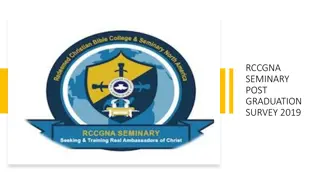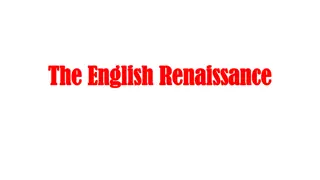Mastering NT Greek Vocabulary Builder Unit 7: Erasmian or Seminary Pronunciations
This content showcases Unit 7 of the Vocabulary Builder series focusing on Greek words with both Greek-English and English-Greek translations, along with pronunciations. Each image contains words with their meanings and pronunciations, aiding in language learning and comprehension.
Download Presentation

Please find below an Image/Link to download the presentation.
The content on the website is provided AS IS for your information and personal use only. It may not be sold, licensed, or shared on other websites without obtaining consent from the author.If you encounter any issues during the download, it is possible that the publisher has removed the file from their server.
You are allowed to download the files provided on this website for personal or commercial use, subject to the condition that they are used lawfully. All files are the property of their respective owners.
The content on the website is provided AS IS for your information and personal use only. It may not be sold, licensed, or shared on other websites without obtaining consent from the author.
E N D
Presentation Transcript
Writing a Laboratory Report Students will be able to: Describe a laboratory report Appropriately process data obtained from an investigation Interpret data and draw a valid conclusion Evaluate an investigation describing its limitation, challenges faced, and improvement needed
Writing a Laboratory Report Key Vocabulary: Average Conclusion Data Evaluation Interpretation Outlier
Writing a Laboratory Report Once you are done conducting an experiment and is able to gather sufficient data, you must be ready to report your findings. A laboratory report is a written report that explains what you did in the experiment, what you learned, and what the results meant.
Writing a Laboratory Report A laboratory report provides details of the investigation which aims to clearly communicate its findings. This investigation write up has three parts: 1. Processing data 2. Interpreting data 3. Evaluating investigation
Writing a Laboratory Report Processing data means organizing the collecteddata for easier interpretation. Data are often organized in a tabular form. Conducting repeated tests for each value for the independent variable gives a range of data that can be used to calculate average.
Writing a Laboratory Report The averageis the result obtained after adding two or more numbers together and dividing the total by the number of values added together. Finding an average provides an idea as to an overall behavior or trend of data collected. This result may be displayed as a graph to easily see the trend.
Writing a Laboratory Report Comprehension check Calculate the average temperature of water with increasing number of effervescent tablets. Temperature of Water (0C) No. of Effervescent Tablet in a 50-mL of Water Trial 1 Trial 2 Trial 3 Average 0 23 23 24 23.3 1 20.2 21 22 2 18 19 20.2 3 16 17 18.1 4 14 15 14.2
Writing a Laboratory Report Comprehension check Answers Calculate the average temperature of water with increasing number of effervescent tablets. Temperature of Water (0C) No. of Effervescent Tablet in a 50-mL of Water Trial 1 Trial 2 Trial 3 Average 0 23 23 24 23.3 1 20.2 21 22 21.1 2 18 19 20.2 19.1 3 16 17 18.1 17.0 4 14 15 14.2 14.4
Writing a Laboratory Report Numerical data is usually presented as a graph of averages. Graphs are very useful tools in science as they allow better visualization of a set of data. With a graph, it is easier to see what all the numbers in a data table mean. This makes interpretation of data easier and more accurate.
Writing a Laboratory Report There are three commonly used types of graphs in science. Each type of graph is suitable for showing a different type of data. bar graph Bar graphs are especially useful for comparing values for different things. For instance, comparing the number of girls and boys in a class, or the average age of students in a grade level. pie graph line graph
Writing a Laboratory Report Pie graphs are used to show percent (or fractions) of a whole, such as the percent of a population of a certain plant in a garden. bar graph Line graphs are especially useful for showing changes over time, or time trends in data, such as how the average growth of plant changes over time. pie graph line graph
Writing a Laboratory Report Once the data has been processed, it is now time to do data analysis. It is the process of interpreting the meaning of the data collected. This process involves looking for patterns such as similarities, differences, trends, and other relationships to make sense of what they could probably mean.
Writing a Laboratory Report In interpreting data, it is necessary to determine the relationship between independent and dependent variables. Is it directly proportional wherein the dependent variable increases when the independent variable is increased? Is it inversely proportional wherein the dependent variable decreases when the independent variable is increased? directly proportional inversely proportional
Writing a Laboratory Report After data analysis, the next step in writing up an investigation is to draw a conclusion about the hypothesis formulated. A conclusion is a final claim that states what is learned from conducting the investigation. It is a summary of the inferences that have been made based on data analysis.
Writing a Laboratory Report In drawing a conclusion, it is important to ask whether the collected data supports the hypothesis or not. If the conclusion supports the hypothesis, it is important to include both the independent and dependent variables to emphasize their relationship.
Writing a Laboratory Report Comprehension check What conclusion can you derive from the given set of data?
Writing a Laboratory Report Comprehension check Answer What conclusion can you derive from the given set of data? The temperature of water decreases as more effervescent tables are added into it.
Writing a Laboratory Report The final stage of any investigation is evaluation or providing assessment or judgment on whether the results obtained were valid and reliable. This also includes a reflection of the challenges encountered in doing the experiment, its limitations as well as how else it can be improved to get better results the next time it will be conducted.
Writing a Laboratory Report During evaluation, it is necessary to look for an outlier or a data that differs dramatically from others. The number encircled seems close to the data obtained in Trials 1 and 2. But looking at the gap in the temperature between 3 and 4 tablets placed in water, it is unusually high making it an outlier.
Writing a Laboratory Report If an outlier is found, it is recommended to find out the source of error in collecting data. This can be done by reflecting on any problems or difficulties encountered during data collection. Realizing how these sources of errors were controlled is important so as not to make the same mistakes again.
Writing a Laboratory Report Upon thorough evaluation, modify the method used in the investigation to ensure that a more reliable result will be obtained in case the experiment will be repeated. Provide recommendations too, on how the investigation may be improved in case others would like to conduct the same investigation or use it as a basis for a new investigation.























